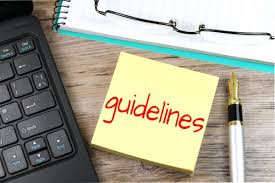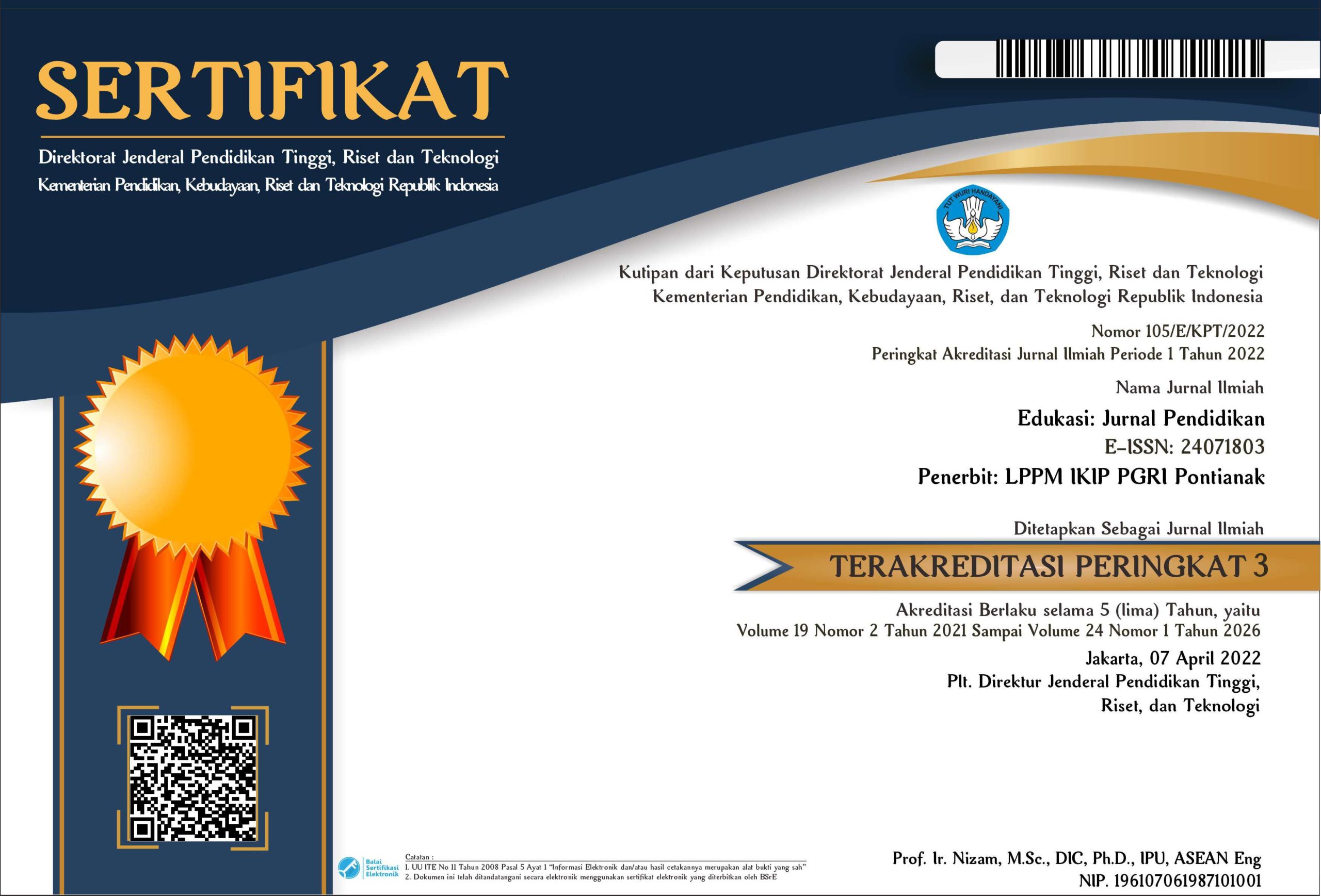Written Corrective Feedback in Academic Writing Class: How Does Experienced Teacher Lead the Effective Practice?
DOI:
https://doi.org/10.31571/edukasi.v19i1.2315Keywords:
writing teacher, academic writing, written corrective feedback, dosen menulis, menulis akademik, umpan balik koreksi tertulisAbstract
Abstract
The research aimed to investigate an Indonesian academic writing teacher’s practice on written corrective feedback (WCF) in academic writing class. A case study involving an experienced Indonesian academic writing teacher and teacher students were employed. To gather data, a semi-structured interview was conducted. The data were then analyzed using the content analysis method. The findings indicated that the teacher’s practice on WCF was mediated by her language learning experience. Thus, the teacher provided WCF on her students’ writing drafts by considering the students’ personalities and their level of writing ability. In correcting student writing errors, the teacher used several types of WCF; direct and indirect correction; metalinguistic clues to the errors; and the reformulation of the wrong words. The relevant pedagogical implications for teachers in conceptualizing WCF and in learning and practicing it on their daily instruction based on their knowledge, experience, and reflection-on-practice.
Â
Abstrak
Penelitian bertujuan untuk mendeskripsikan praktik dosen Indonesia dalam penulisan akademik tentang umpan balik korektif tertulis (WCF) di kelas penulisan akademik. Penelitian termasuk studi kasus yang melibatkan seorang dosen Indonesia dalam menulis akademik yang berpengalaman dan mahasiswa. Untuk mengumpulkan data, dilakukan wawancara semi-terstruktur. Data tersebut kemudian dianalisis dengan menggunakan metode analisis isi. Temuan menunjukkan bahwa praktik dosen pada WCF dimediasi oleh pengalaman belajar bahasanya. Dosen memberikan WCF pada draf tulisan mahasiswanya dengan mempertimbangkan kepribadian mahasiswa dan tingkat kemampuan menulisnya. Dalam mengoreksi kesalahan menulis mahasiswa, dosen menggunakan beberapa jenis WCF; koreksi langsung dan tidak langsung; petunjuk kesalahan metalinguistik; dan perumusan ulang kata yang salah. Implikasi pedagogis yang relevan bagi dosen dalam membuat konsep WCF dan dalam mempelajari serta mempraktikkannya pada instruksi harian berdasarkan pada pengetahuan, pengalaman, dan refleksi pada praktik yang dilaksanakan.
Downloads
References
Banaruee, H., Khatin-Zadeh, O., & Ruegg, R. (2018). Recasts vs. direct corrective feedback on writing performance of high school EFL learners. Cogent Education, 5(1), 1-23. http://dx.doi.org/10.1080/2331186X.2018.1455333.
Chen, S., Nassaji, H., & Liu, Q. (2016). EFL learners’ perceptions and preferences of written corrective feedback: A case study of university students from Mainland China. Asian-Pacific Journal of Second and Foreign Language Education, 1(5), 1-17. http://dx.doi.org/10.1186/s40862-016-0010-y.
Ellis, R. (2010). A framework for investigating oral and written corrective feedback. Studies in Second Language Acquisition, 32(2), 335-349. http://dx.doi.org/10.1017/S0272263109990544.
Elola, I., Mikulski, A. M., & Buckner, T. E. (2017). The impact of direct and indirect feedback on the development of Spanish aspect. Journal of Spanish Language Teaching, 4(1), 1-14. http://dx.doi.org/10.1080/23247797.2017. 1315267.
Ferris, D. R. (2015). Written corrective feedback in L2 Writing: Connors & Lunsford (1988); Lunsford & Lunsford (2008); Lalande (1982). Language Teaching, 48(4), 531-544. http://dx.doi.org/10.1017/S0261444815000257.
Ferris, D. R. (2011). Treatment of error in second language student writing (2nd ed.). Ann Arbor: The University of Michigan Press.
Fu, T., & Nassaji, H. (2016). Corrective feedback, learner uptake, and feedback perception in a Chinese as a Foreign Language Classroom. Studies in Second Language Learning and Teaching, 6(1), 159-181. http://dx.doi.org/ 10.14746/ssllt.2016.6.1.8.
Hattie, J., & Yates, G. (2014). Visible learning and the science of how we learn. New York: Routledge.
Jabulani, S. (2017). Efficacy of written corrective feedback on university students’ writing. Journal of Social Sciences, 45(2), 84-95. http://dx.doi.org/10.1080/09718923.2015.11893490.
Kunzman, R. (2003). From teacher to student: The value of teacher education for experienced teacher. Journal of Teacher Education, 54(3), 241-253. http://dx.doi.org/10.1177/0022487103251568.
Lee, I. (2014). Revisiting teacher feedback in EFL writing from sociocultural perspectives. TESOL Quarterly, 48(1), 201-213. http://dx.doi.org/10.1002/ tesq.153.
Park, E. S., Song, S., & Shin, Y. K. (2015). To what extent do learners benefit from indirect written corrective feedback? A study targeting learners of different proficiency and heritage language status. Language Teaching Research, 20(6), 678-699. http://dx.doi.org/10.1177/1362168815609617.
Putra, M. I. P., & Sulaiman. (2016). Students’ attitudes concerning lecturer’s corrective feedback in teaching writing. Jurnal Pendidikan Bahasa, 5(2), 257-272. http://dx.doi.org/10.31571/bahasa.v5i2.329.
Sabarun, S. (2020). Direct teacher corrective feedback in EFL writing class at higher education: What Students Perceive. Vision: Journal for Language and Foreign Language Learning, 9(1), 18-33. http://dx.doi.org/ 10.21580/vjv9i14652.
Susanti, A. (2017). Teachers’ corrective feedback on students’ L2 writing: State of the art. Abjadia: International Journal of Education, 2(2), 81-94. https://doi.org/10.18860/abj.v2i2.5364.
Thomas, K. E. (2018). Comparing explicit exemplar-based and rule-based corrective feedback: Introducing analogy-based corrective feedback. The Modern Language Journal, 102(2), 1-21. http://dx.doi.org/10.1111/ modl.12470.
Vyatkina, N. (2010). The effectiveness of written corrective feedback in teaching beginning German. Foreign Language Annals, 43(4), 671-689. http://dx.doi.org/10.1111/j.1944-9720.2010.01108.x.
Wei, W., & Cao, Y. (2020). Written corrective feedback strategies employed by university English lecturers: A teacher cognition perspective. SAGE Open, 10(3), 1-12. https://doi.org/10.1177/2158244020934886.
Westmacott, A. (2017). Direct vs. indirect written corrective feedback: Student perceptions. Ikala, 22(1), 17-32. http://dx.doi.org/10.17533/udea.ikala. v22n01a02.
Yang, Y-F. (2017). New language knowledge construction through indirect feedback in web-based collaborative writing. Computer Assisted Language Learning, 31(4), 1-22. http://dx.doi.org/10.1080/09588221.2017.1414852.
Yu, S., & Lee, I. (2016). Exploring Chinese students' strategy use in a cooperative peer feedback writing group. System, 58(June), 1-11. http://dx.doi.org/ 10.1016/j.system.2016.02.005.
Yunus, W. N. M. W. M. (2020). Written corrective feedback in English compositions: Teachers’ practices and students’ expectations. English Language Teaching Educational Journal, 3(2), 95-107. https://doi.org/ 10.12928/eltej.v3i2.2255.
Zabihi, S. (2013). The effect of recast on Iranian EFL learners’ writing achievement. International Journal of Applied Linguistics and English Literature, 2(6), 28-35. http://dx.doi.org/10.7575/aiac.ijalel.v.2n.6p.28.
Zheng, Y., & Yu, S. (2018). Student engagement with teacher written corrective feedback in EFL writing: A case study of Chinese lower-proï¬ciency students. Assessing Writing, 37(July), 13-24. http://dx.doi.org/10.1016/ j.asw.2018.03.001.
Downloads
Published
How to Cite
Issue
Section
License
Authors who publish in this journal agree to the following terms:
- Authors retain copyright and grant the journal the right of first publication with the work simultaneously licensed under a Creative Commons Attribution License (CC-BY-NC) that allows others to share the work with an acknowledgment of the work's authorship and initial publication in this journal.
- Authors are able to enter into separate, additional contractual arrangements for the non-exclusive distribution of the journal's published version of the work (e.g., post it to an institutional repository or publish it in a book), with an acknowledgment of its initial publication in this journal.
- Authors are permitted and encouraged to post their work online (e.g., in institutional repositories or on their website) prior to and during the submission process, as it can lead to productive exchanges, as well as earlier and greater citation of published work.

 Download: 337
Download: 337


















